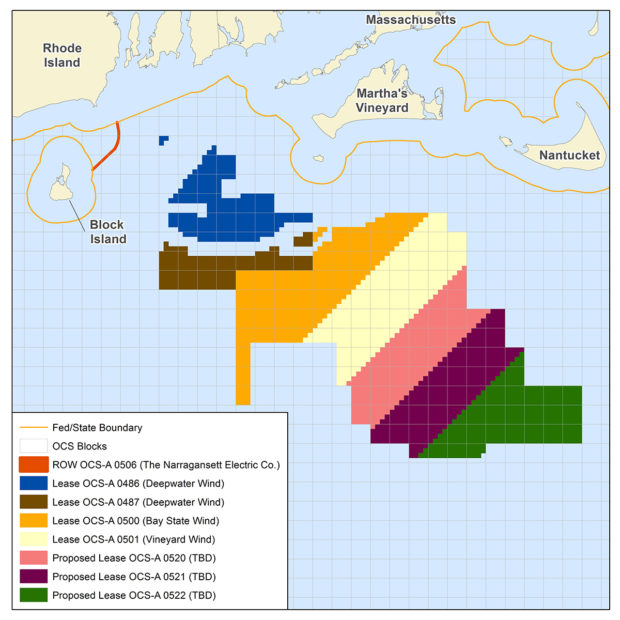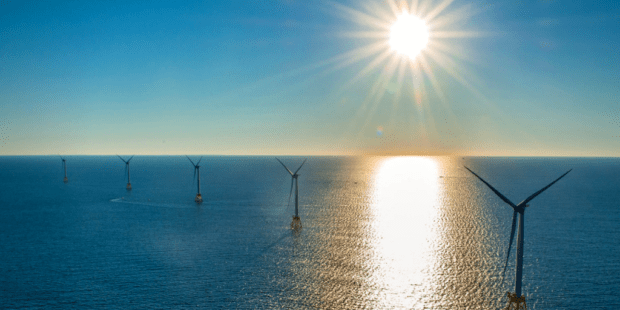We have much more to do and your continued support is needed now more than ever.
Offshore Wind Lease Auction Blows Old Record Out of the Water

What a difference a few years and visionary leadership can make. This morning, developers finished 32 rounds of bidding on areas of federal waters off the coast of Massachusetts designated for offshore wind power development. The three areas drew a collective total of just over $405 million. Moving from west to east, the winning bidders are Equinor Wind, Mayflower Wind Energy, and Vineyard Wind, with bids of $135 million, $135 million, and $135.1 million, respectively.
The federal government has been holding offshore wind energy auctions since 2013, and in early 2015 offered this same portion of the ocean for auction… but there were no bidders. Until today, the highest bid on an offshore wind energy area was $42 million, for an area off of New York that Equinor (formerly Statoil) won just two years ago.
Zero to hundreds of millions in four years– what happened?!
What has changed to spike such intense competition? Quite a bit, actually. Despite the fact that the U.S. has yet to get a single offshore wind turbine built in federal waters (the nation’s only five turbines stand in Rhode Island state waters), globally speaking the offshore wind industry is booming – and has been growing for decades. The U.S. Atlantic Coast is prime for offshore wind development; it’s home to plenty of demand for power, a strong and consistent wind resource, and a gradually sloping outer continental shelf essential for fixing turbines to the seafloor.
Offshore wind developers worldwide have had an eye on this part of the planet for quite some time – while eagerly awaiting a shift in the political climate.
Back in 2015, while thousands of offshore wind turbines operated to great success around the globe, decision-makers in the U.S. were still grappling with whether to support the concept. There was some policy progress in the Mid-Atlantic, but not a single Northeast state had made a large-scale commitment to offshore wind power development. Massachusetts’s Cape Wind project had just lost its utility contracts after over a decade of legal battles with deep-pocketed opponents unwilling to share Nantucket Sound with wind turbines, and the few developers willing to take the gamble on U.S. development had already acquired a handful of other lease areas – stretching any thinner with such uncertainty would have been tough to justify.

Since then, the U.S. offshore wind story has turned from a crawl to a full sprint. The Block Island Wind Farm is up and running, demonstrating what these feats of engineering are capable of: replacing fossil fuel-fired power plants and providing clean, domestic power right when and where we need it most. Massachusetts, New York, and New Jersey have made assertive commitments to develop enough offshore wind power for hundreds of thousands of homes apiece. Massachusetts, New York, Rhode Island, and Connecticut are advancing specific project contracts. It’s a new day for offshore wind power in the Northeast. The opportunity is here and now, and developers are vying to get in the game.
“This historic auction clearly demonstrates investor confidence in America’s offshore wind market, thanks to the leadership of states like Massachusetts, New York, and New Jersey that have set long term, large scale commitments to finally bring this critically needed climate solution online… The National Wildlife Federation applauds the Bureau of Ocean Energy Management for a successful auction and congratulates Equinor Wind, Mayflower Wind Energy and Vineyard Wind for securing these new leases. Looking forward, we will continue to work with all leaseholders to ensure that coastal and marine wildlife are protected throughout every stage of the offshore wind development process.”
- Collin O’Mara, president and CEO of the National Wildlife Federation (See full statement here.)
What’s next?

There’s still a long way to go from here. Developers now need to learn the details of their areas, design projects, secure power contracts and an extensive number of permits, and much more. There are public comment periods every step of the way, and ample opportunity to raise and work through concerns.
The National Wildlife Federation looks forward to working with these new lease holders to ensure that wildlife and habitat will be protected throughout every stage of surveying and development. We will continue to advocate for the swift and responsible development of offshore wind power, and we hope you will join us in speaking up for this important clean energy solution. Offshore wind power can play a key role in transforming our energy profile into one we can be proud of – and it will take all of us pushing in that direction to ensure we seize the opportunity closer to our grasp than ever before.
TAKE ACTION: Call on your Governor to make offshore wind power part of your state’s energy mix!





















